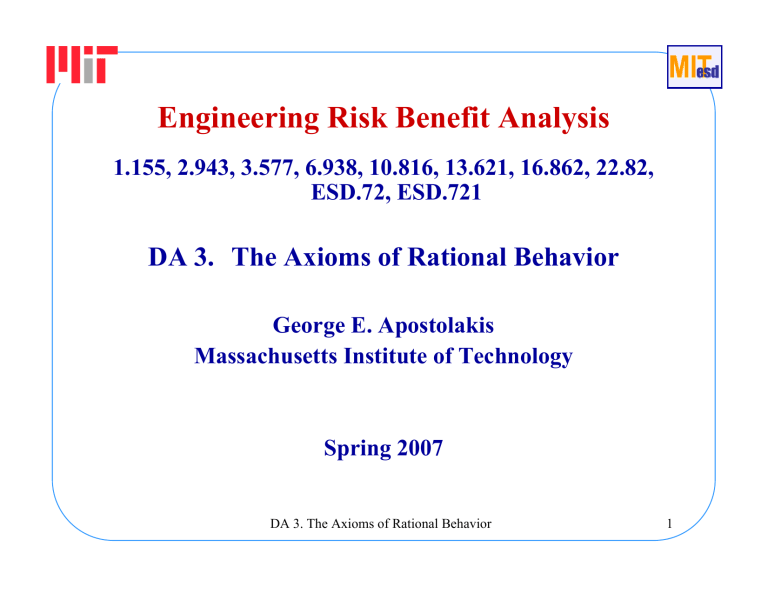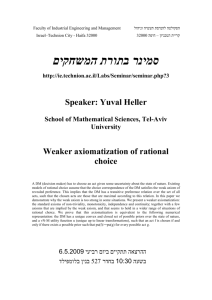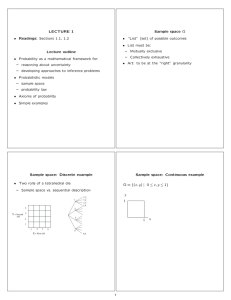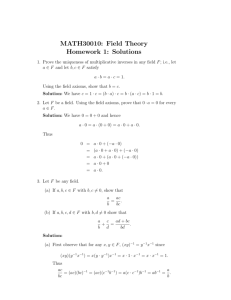Engineering Risk Benefit Analysis DA 3. The Axioms of Rational Behavior

Engineering Risk Benefit Analysis
1.155, 2.943, 3.577, 6.938, 10.816, 13.621, 16.862, 22.82,
ESD.72, ESD.721
DA 3. The Axioms of Rational Behavior
George E. Apostolakis
Massachusetts Institute of Technology
Spring 2007
DA 3. The Axioms of Rational Behavior 1
Lotteries
• A lottery is a probabilistic trial characterized by a set of mutually exclusive and exhaustive possible outcomes C
1
, C
2
,
…, C m
, with respective probabilities p
1
, p
2
, …, p m
.
• L(C
1
, C
2
, …, C m
; p
1
, p
2
, …, p m
)
Example: L($5, $0; 0.6, 0.4)
0.6
$5
L:
0.4
$0
DA 3. The Axioms of Rational Behavior 2
Preferences exist
• For every pair of consequences C i will: and C j
, a DM
¾ prefer C i to C j
⇒
C i f
C j
¾ be indifferent between C i and C j
⇒
C i
~ C j
¾ prefer C j to C i
⇒
C i p C j
DA 3. The Axioms of Rational Behavior 3
Definition of C * and C
*
• Define:
¾
C * a consequence that is at least as preferred as the most preferred of C
1
… C m
⇒
C * f C i for all i
¾
C
* a consequence that is at least as low in preference as the least preferred of C
1
C
* p C i for all i
… C m
⇒
• C * and C
* need not be included in C
1
… C m
DA 3. The Axioms of Rational Behavior 4
The desirability of a lottery
It depends on:
• The probabilities
• The consequences
• The person’s present wealth, needs, and attitude toward risk.
DA 3. The Axioms of Rational Behavior 5
Axiom 1: Comparison of lotteries with identical consequences
Given: L
1 f
= L (C * , C
* i f
C
*
;p
1
, 1 - p
1
), L
2
= L (C * , C
*
; p
2
, 1 - p
2
) for all i, then a Decision Maker will: prefer L
1 over L be indifferent
2 if p
1
> p
2
, if p
1
= p
2 prefer L
2 over L
1 if p
1
< p
2
.
• Given the same consequences, the DM prefers the lottery with the higher probability of achieving the most desirable consequence.
DA 3. The Axioms of Rational Behavior 6
Axiom 2a: Quantification of preferences
For each C i
, the DM can specify a number
π
(C with 0
≤ π
(C i i
),
)
≤
1, such that the DM is indifferent between: possessing C i with certainty and possessing the lottery L (C*, C
*
;
π
(C i
), 1 -
π
(C i
))
DA 3. The Axioms of Rational Behavior 7
Notes on Axiom 2a
• The indifference probability (or "preference value")
π
(C i
) is a measure of the preference of C i a range of consequences from C
* to C*.
on
• This axiom provides the basis for the development of the metric of “utility” (“preference value”).
• From Axiom 1, the DM will prefer C the lottery L (C * , C
* i for sure over
;p , 1 - p), if p
< π
(C i
).
DA 3. The Axioms of Rational Behavior 8
Axiom 2b: Quantification of uncertainty
Let R be any event. For each R, the DM has a indifferent between
• the lottery L (C* , C
*
; p(R) , 1 - p(R))
• a lottery as a result of which the DM will obtain C* if R occurs and C
* if R does not occur.
DA 3. The Axioms of Rational Behavior 9
Notes on Axiom 2b
• Judgmental probabilities exist for a rational DM.
• This axiom provides the means for finding the
DM’s probability of R. All the DM has to do is adjust p(R) until he/she is indifferent between the two lotteries.
DA 3. The Axioms of Rational Behavior 10
Axiom 3: Transitivity of preferences
If C
1
, C
2 and C
3 are consequences, then:
C
1
~ C
2 and C
2
~ C
3 implies C
1
~ C
3 and
C
1 f
C
2 and C
2 f
C
3 implies C
1 f
C
3
DA 3. The Axioms of Rational Behavior 11
Axiom 4: Substitution of consequences
If C
1
~ C
2
, then the DM is indifferent between two decision problems which are identical except that
C
1 in the first problem has been substituted by C
2 in the second.
[If a DM is indifferent between two consequences, the DM's solution to a decision problem cannot be affected by substitution of one of these consequences for the other.]
DA 3. The Axioms of Rational Behavior 12
C
1
C
2
C m p
1 p
2
π
( C
1
)
C
1
1−π
( C
1
)
π
( C
2
)
C
2
1−π
( C
2
)
C *
C
*
C *
C
* p m
C m
π
( C m
)
1−π
( C m
)
C
*
C
*
DA 3. The Axioms of Rational Behavior 13
Axiom 5: Equivalence of preferences for actual and conjectural situations
Let C
1 and C be any two consequences which are possible if
2 only some chance event R occurs. After it is known that R did indeed occur, the DM should have the same preference between C
1 and C
2 that the DM had before (s)he knew whether or not R occurred.
[A DM's preferences among consequences of a decision should not be affected by knowledge as to whether (s)he merely may or (s)he certainly will have to make that decision.]
DA 3. The Axioms of Rational Behavior 14
Summary of Axioms
• Axiom 0: Preferences exist
• Axiom 1: Two simple lotteries, each with same prize and penalty: choose lottery with higher probability of prize
• Axiom 2a: Quantification of preferences ("indifference probability" or "preference value")
• Axiom 2b: Quantification of uncertainty
• Axiom 3: Transitivity of preferences
DA 3. The Axioms of Rational Behavior 15
Summary of Axioms (cont’d)
• Axiom 4: Substitution of consequences
• Axiom 5: Equivalence of preferences for actual and conjectural situations
A DM who satisfies these axioms is rational or coherent.
DA 3. The Axioms of Rational Behavior 16








